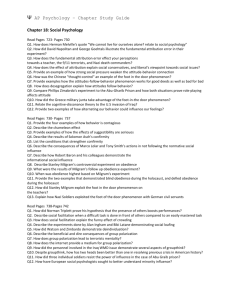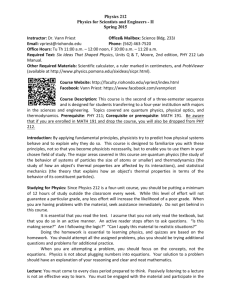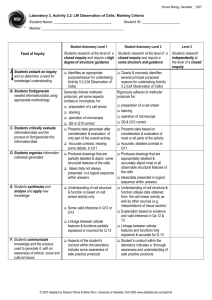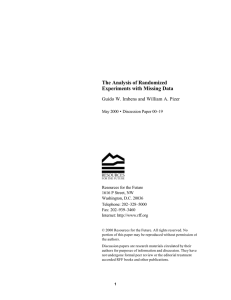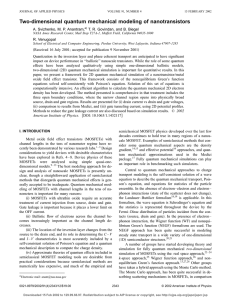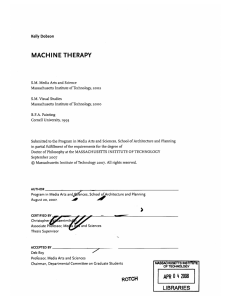Chapter 18: Social Psychology
advertisement
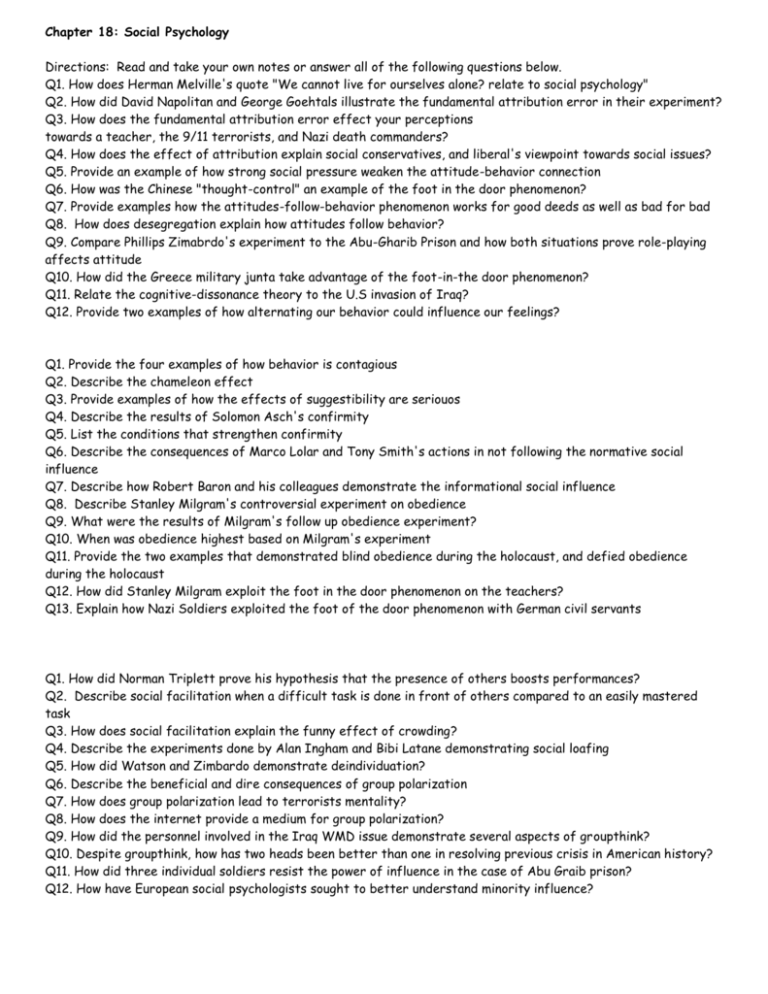
Chapter 18: Social Psychology Directions: Read and take your own notes or answer all of the following questions below. Q1. How does Herman Melville's quote "We cannot live for ourselves alone? relate to social psychology" Q2. How did David Napolitan and George Goehtals illustrate the fundamental attribution error in their experiment? Q3. How does the fundamental attribution error effect your perceptions towards a teacher, the 9/11 terrorists, and Nazi death commanders? Q4. How does the effect of attribution explain social conservatives, and liberal's viewpoint towards social issues? Q5. Provide an example of how strong social pressure weaken the attitude-behavior connection Q6. How was the Chinese "thought-control" an example of the foot in the door phenomenon? Q7. Provide examples how the attitudes-follow-behavior phenomenon works for good deeds as well as bad for bad Q8. How does desegregation explain how attitudes follow behavior? Q9. Compare Phillips Zimabrdo's experiment to the Abu-Gharib Prison and how both situations prove role-playing affects attitude Q10. How did the Greece military junta take advantage of the foot-in-the door phenomenon? Q11. Relate the cognitive-dissonance theory to the U.S invasion of Iraq? Q12. Provide two examples of how alternating our behavior could influence our feelings? Q1. Provide the four examples of how behavior is contagious Q2. Describe the chameleon effect Q3. Provide examples of how the effects of suggestibility are seriouos Q4. Describe the results of Solomon Asch's confirmity Q5. List the conditions that strengthen confirmity Q6. Describe the consequences of Marco Lolar and Tony Smith's actions in not following the normative social influence Q7. Describe how Robert Baron and his colleagues demonstrate the informational social influence Q8. Describe Stanley Milgram's controversial experiment on obedience Q9. What were the results of Milgram's follow up obedience experiment? Q10. When was obedience highest based on Milgram's experiment Q11. Provide the two examples that demonstrated blind obedience during the holocaust, and defied obedience during the holocaust Q12. How did Stanley Milgram exploit the foot in the door phenomenon on the teachers? Q13. Explain how Nazi Soldiers exploited the foot of the door phenomenon with German civil servants Q1. How did Norman Triplett prove his hypothesis that the presence of others boosts performances? Q2. Describe social facilitation when a difficult task is done in front of others compared to an easily mastered task Q3. How does social facilitation explain the funny effect of crowding? Q4. Describe the experiments done by Alan Ingham and Bibi Latane demonstrating social loafing Q5. How did Watson and Zimbardo demonstrate deindividuation? Q6. Describe the beneficial and dire consequences of group polarization Q7. How does group polarization lead to terrorists mentality? Q8. How does the internet provide a medium for group polarization? Q9. How did the personnel involved in the Iraq WMD issue demonstrate several aspects of groupthink? Q10. Despite groupthink, how has two heads been better than one in resolving previous crisis in American history? Q11. How did three individual soldiers resist the power of influence in the case of Abu Graib prison? Q12. How have European social psychologists sought to better understand minority influence? Q1. Explain how prejudice is an unjustifiable and usually negative attitude towards a group? Q2. Provide examples of implicit racial associations, unconscious patronization, race-influenced perceptions, seeing black, and reflexive bodily responses Q3. Provide examples of modern prejudices in public settings Q4. Provide examples of gender prejudice and discrimination Q5. How does prejudice rationalize inequalities, and describe the blame the victim dynamic? Q6. Describe ingroup bias and out group in reference to high school cliques Q7. Provide example of the scapegoat theory, and how it restores self-esteem to individuals? Q8. Describe the effects of categorizing people into groups Q9. How do vivid cases feed stereotypes? Q10. Provide an example of the just-world phenomenon Q11. How did the experiment conducted by Ronnie Janoff-Bulman and her collaborators illustrate the phenomenon of blaming the victim and hindsight bias? Q1. List the facts of gun violence and how they contribute to murder? Q2. Describe the three examples of neural influences on aggression? Q3. Describe the links between testosterone and aggressive behavior in humans and animals Q4. Provide examples of how does frustration and other aversive stimuli evoke hostility Q5. How does ostracism, or rejected induced aggression induce school violence? Q6. How did Richard Nisbett and Dov Cohen show how violence can vary by culture within a country? Q7. How does social influence appear in high violence rates among cultures? Q8. List some factors that might sexual aggression amongst men towards women, and Zillman’s follow-up studies Q9. Describe the rape myth Q10. How might acquiring social scripts attribute to violence? Q11. Describe some of the studies researching video games and violence Q12. How does the correlation between violence and video games disconfirm the catharsis hypothesis? Q13. Describe real-life situations that display social traps Q14. Provide an example of mirror-image perceptions Q1. Why is proximity conducive to liking? Q2. How does the mere exposure effect applies to ourselves, and how was it adaptive for our ancestors? Q3. Describe the wide-ranging effects of people’s physical attractiveness Q4. Describe the two findings of attractiveness that the Roman statesman Cicero might have been reassured by? Q5. List the aspects of attractiveness that do cross place and time, and the physical features people prefer Q6. As you get to know someone better, is the chemistry better if you are opposites or if you are alike? Q7. Describe the reward theory of attraction Q8. Provide evidence of arousal is a key ingredient of passionate love Q9. Why is important for married couples to understand that passionate love has a short duration compared to companionate love, how do these views affect western and non-western cultures? Q10. How is equity a key to a gratifying and enduring relationship? Q11. Describe the experiment that demonstrated self-disclosure as a vital ingredient of a vital relationship? Q1. Describe the two examples of altruism that took place in Rwanda in 1994 Q2. Describe the case of Kitty Genovese, and why it alarmed social psychologists Q3. Describe the decision scheme for bystander intervention Darley and Latane assembled Q4. Describe the experiment conducted by Latane, Dabbs, and 15 collaborators to demonstrate the bystander effect, and describe the 8 patterns found most useful in adding others? Q5. How does a more religious approach to life reflect the social-responsibility norm? Q6. Describe the experiment conducted by researcher Muzafer Sherif, and how were superordinate goals introduced, and it’s involvement in the outcome of the experiment Q7. How did 9/11 produce a powerfully unifying effect for different groups? Q8. How do superordinate goals override differences? Q9. How does a mediator play a role in resolving real-life conflicts? Q10. In laboratory experiments, how has GRIT been the most effective strategy known for increasing trust and cooperation? Q11. What observations Thomas Sowell make that promoted social diversity between cultures?
